The word pentatonic gets it’s name from the Greek word “penta” which means 5 and tonic which stands for tone. That’s what pentatonic scales are: 5 tone scales.
There are only 5 basic pentatonic patterns. They are the C, A, G, E, and D. They are similar to the 5 basic chord patterns, because they can be closely associated with their chord counterparts. These patterns interlock with each other, meaning each pattern has notes that overlap with patterns adjacent to it.
To play in different key signatures we move the patterns around. The pictures on the left are the shapes with their suggested fingerings. The pictures on the right show how the scale shapes overlap the chord shape.
- These shapes are in their movable form. Learn about moving scale shapes to play in different keys besides C, A, G, E, and D.
- Also, check out the open pentatonic scale shapes, too. They are the same shapes, but we have to make a couple of alterations that you’ll want to be aware of.
- Check out the scale sequence charts: C scale sequence, A scale sequence, G scale sequence, E scale sequence, D scale sequence. Scale sequence charts are a way for us to see how the basic scale patterns are laid out on the fretboard in a particular key.
- There are five minor pentatonic scale shapes as well. They are actually the same shapes, but are associated with different chords in the CAGED sequence.
C Shape
Here is the scale pattern played in the key of C#/Db, because the root
note appears on the 4th fret of the A string.
As with all patterns it can be transposed to any key. The pattern remains
the same. Here is the same pattern in the key of F, because the root
note
appears on the 8th fret of the A string which is an F note.
Notice that it looks the same when played. The only difference is that
the pattern is being played higher up on the fretboard:
A Shape
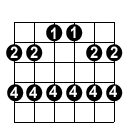
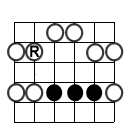
Below is the A scale pattern in the key of C#/Db, because the root note
appears on the 4th fret of the A string.

G Shape
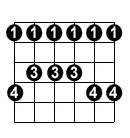
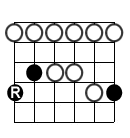
Below is the G scale pattern in the key of C#/Db, because the root note
appears on the 9th fret of the low E string.

E Shape

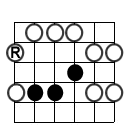
Below is the E scale pattern in the key of D, because the root note appears
on the 10th fret of the low E string.

D Shape

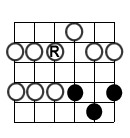
Below is the D scale pattern in the key of B, because the root note appears
on the 9th fret of the D string which is a B note.




